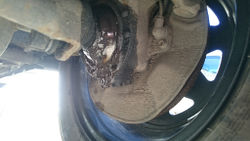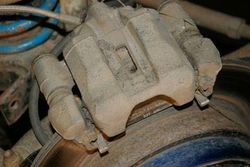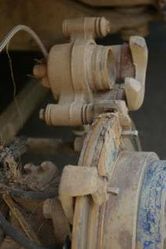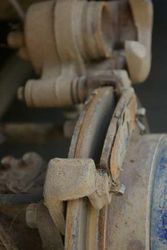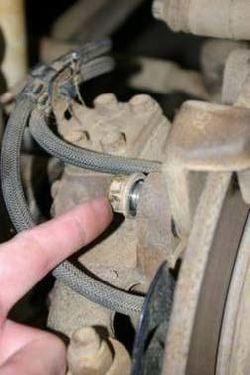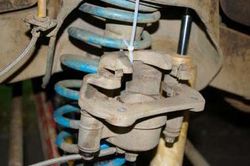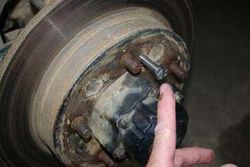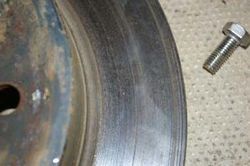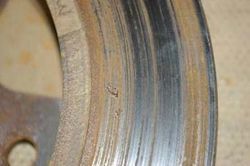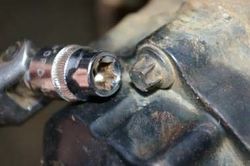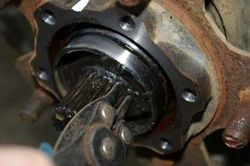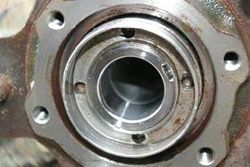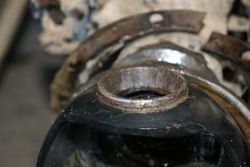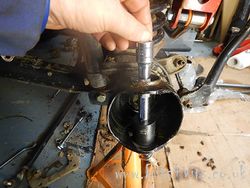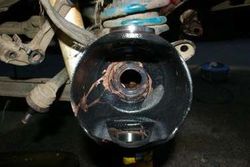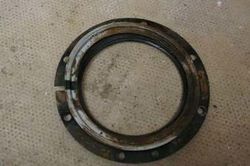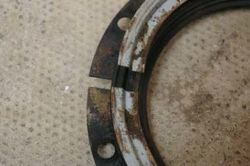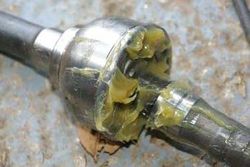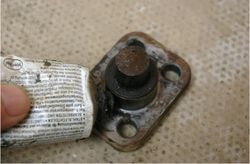Difference between revisions of "Martins Test"
| Line 73: | Line 73: | ||
With the hub removed the driveshaft is exposed. The driveshaft is retained with a circlip so use a pair of circlip pliers to remove it. This is really fiddly and can be an annoying task. Behind the circlip is a rectangular washer that should also be removed. Note that I have also marked with white paint the orientation of the freewheeling hub, this is not strictly needed. | With the hub removed the driveshaft is exposed. The driveshaft is retained with a circlip so use a pair of circlip pliers to remove it. This is really fiddly and can be an annoying task. Behind the circlip is a rectangular washer that should also be removed. Note that I have also marked with white paint the orientation of the freewheeling hub, this is not strictly needed. | ||
<br clear=all> | <br clear=all> | ||
| − | [[File: | + | [[File:Hub_ring.jpg|thumb|250px|left|The hub nut]] |
| − | + | Now for the special tool. The hub is held on by a special round nut that requires a special tool to release it. The outside of the nut is a smooth polished ring which is part of the vacuum seal so it must not be damaged otherwise you will need a new nut(which is exceedingly expensive!). | |
<br clear=all> | <br clear=all> | ||
| − | |||
| − | |||
| − | |||
| − | |||
| − | |||
| − | |||
| − | |||
| − | |||
| − | |||
| − | |||
| − | |||
| − | |||
| − | |||
| − | |||
| − | |||
| − | |||
<br clear=all> | <br clear=all> | ||
The bearings are Koyo brand as standard. The BigJimny store has two kits available, the [https://www.bigjimny.com/store/kingpin-bearing-kit-suzuki-jimny-koyo.html basic kit] has the two bearings and the small oil seal required to do one side. The [https://www.bigjimny.com/store/kingpin-bearing/seal-kit-suzuki-jimny.html full kit] also included the large external seal although some people choose not to change this. The thing to remember is that it is not a Landrover which has oil filled swivels. The joints on Jimnys should be "dry" apart from some lubricating grease. | The bearings are Koyo brand as standard. The BigJimny store has two kits available, the [https://www.bigjimny.com/store/kingpin-bearing-kit-suzuki-jimny-koyo.html basic kit] has the two bearings and the small oil seal required to do one side. The [https://www.bigjimny.com/store/kingpin-bearing/seal-kit-suzuki-jimny.html full kit] also included the large external seal although some people choose not to change this. The thing to remember is that it is not a Landrover which has oil filled swivels. The joints on Jimnys should be "dry" apart from some lubricating grease. | ||
Revision as of 13:58, 3 June 2016
Contents
Front Wheel Bearings
Introduction
The Front Wheel Bearings on a Jimny can be prone to wearing, particularly when used off-road. Providing you have the correct tools it can be straight forward task.
It is also closely tied in with changing/working on the kingpin bearings so some of the steps are duplicated. So what are the symptoms of worn Wheel bearings:
- Grating/Grinding as you rotate a jacked up wheel
- Steering Shimmy, see Death Wobble
- Oil/Grease leaking from Swivel Joint
- Horizontal play in the front wheel (with the car jacked up grip the wheel sides, there will be movement if they are worn. Get an assistant to press the brakes and the movement should disappear)
It is also common not to experience any play at all and to even pass an MOT with a really bad bearing. This is because the bearings are dual race and only one race may have failed.
Changing the bearings
Tools
- Standard metric sockets and spanners
- Assorted screwdrivers
- Hub Nut Tool
- Circlip pliers (External)
- An E10 Torx socket for the Vacuum Hub Bolts
- A ball joint splitter
- 1" Imperial Socket
- G-Clamp or brake piston retractor
Removing the Caliper and pads
First of all secure the car, release the wheel nuts and jack up the car and remove the road wheel. This then reveals the brake caliper, this is the passenger side (nearside) caliper (UK)
Using a 12mm spanner, release the front caliper bolt (the left is the front of the car in this picture) and loosen the same bolt on the rear of the caliper.
The caliper then opens up using the rear bolt as a hinge.
The pads are retained by small spring clips, a simple pull on the pads (horizontally away from the disk) should remove them (or gently prise out the pads with a small screwdriver - do not remove the spring clips). If you require new pads, spring clips or a caliper fitting kit then these are available in the BigJimny Store.
Removing the Brake Disc
The caliper is held on with two bolts at the rear (see below).
Release the bolts and tie the caliper to the spring to keep it out of the way.
Now the front brake disc can be removed. If you are lucky it will simply pull off but if you have problems then there are two M8 holes in the disk hub. Simply run two bolts into these holes and the disk will push off the hub. The picture below shows a bolt being used to push the disk off the hub.
My disk appeared to be ok on the visible side but the rear showed some bad wear so I will change them as part of this job. New disks are available in the BigJimny Store.
Dismantling the Hub
Now the Freewheeling Hub needs to be removed. Suzuki have used Torx bolts to secure these so you will require an E10 socket to remove the bolts.
With the hub removed the driveshaft is exposed. The driveshaft is retained with a circlip so use a pair of circlip pliers to remove it. This is really fiddly and can be an annoying task. Behind the circlip is a rectangular washer that should also be removed. Note that I have also marked with white paint the orientation of the freewheeling hub, this is not strictly needed.
Now for the special tool. The hub is held on by a special round nut that requires a special tool to release it. The outside of the nut is a smooth polished ring which is part of the vacuum seal so it must not be damaged otherwise you will need a new nut(which is exceedingly expensive!).
The bearings are Koyo brand as standard. The BigJimny store has two kits available, the basic kit has the two bearings and the small oil seal required to do one side. The full kit also included the large external seal although some people choose not to change this. The thing to remember is that it is not a Landrover which has oil filled swivels. The joints on Jimnys should be "dry" apart from some lubricating grease.
The next stage is to CLEAN, CLEAN and then CLEAN again. Clean the swivels inside and out, clean the knuckles and pull out the drive shaft and clean that as well.
The rebuild
Once clean you can start the rebuild process. The KingPin bearings come in two parts, the race and an outer ring. This ring is still in the swivel and needs driving out.
A simple way to drive them out is to use a 1" Imperial socket. Using an extension bar fed through the swivel place the 1" Socket behind the ring and drive it out by hitting it. (picture from Dave at Bits4Vits
The new rings can then be driven into place with a piece of wood to protect them from the hammer, again this is seen in the video (picture needed here).
I also hooked out the small axle shaft oil seal and put a new one in from the BigJimny kit. (picture needed here).
Here is the completed swivel with new rings and oil seal (and plenty of copper grease to help them all into place.
If you are changing the large seal then now is the time to put the new one on. The confusing part is the order of the seals and rings on the swivel, the picture below is of the correct orientation, note also that the slits in the retainers go to the top.
Pack the CV with grease (but do not overpack) and re-fit the driveshaft. A suitable waterproof grease is available in the BigJimny Shop.
Grease the new KingPin bearings and insert the top one in the carrier. I find the easiest way to grease the bearings is to put them in a polythene bag with some grease and use thebag to squeeze the grease into the bearing, this can be seen in the video. (picture needed here) .Carefully insert the new bottom bearing and, holding it in place, slide the whole knuckle onto the hub. Fill the Knuckle with 100ml of grease, Suzuki recommend only 100ml and not to overfill. Now the KingPins need to be inserted, but first they need a bead of sealant around the KingPin. Again the BigJimny shop sells suitable sealant.
Make sure that you have put the correct Kingpin in place, remember you should have marked them when you dismantled it!
Bolt the Kingpins in and tighten them to the correct torque (18ft/lbs)
Refit the steering arm (or arms if it is the side with two connections), tightening the nuts to 31ft/lbs
Fit the disk and fit the caliper (Caliper bolts 61ft/lbs), brake pads and bolt the caliper down in position (Caliper pin bolt 16/ft/lbs)
Re-fit the wheel and lower the vehicle.
Torque Settings
Full details of the torque settings can be found in the reference data
Page last edited on 3/06/2016 by user Mlines
